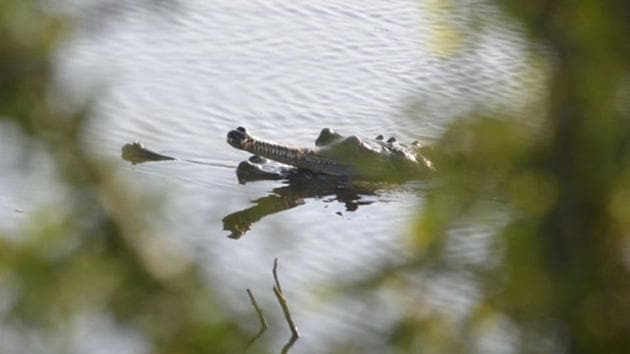Chambal river’s gharials migrate to Kuno as sand mining disturbs habitat
Forest officers say illegal mining disturbs the gharials’ nesting sites and destroys pools and colonies of the reptile.
Rampant illegal sand mining in the Chambal river that has allegedly disturbed the habitat of gharials is suspected to be the reason that forced a female gharial to travel 15 km to lay eggs on the banks of Kuno river, a forest official said Sunday.

The Kuno is a tributary of the Chambal.
The radio-collared gharial chose the banks of the Kuno river for nesting this year, recording the state’s first case of the crocodile species migrating to Kuno river. In 2017, another radio-collared gharial was found nesting in Parbati river, another tributary of the Chambal.
In 2017, the scientists associated with Madras Crocodile Bank Trust and Centre for Herpetology (MCBTCH) fitted radio collars in some gharials under telemetry research to know about their movements and lifestyle.
MCBTCH scientist Zailabdeen Sheikh said, “During telemetry research, we have found that a female gharial went to Kuno but didn’t return. When we traced it, a nest and the gharial were found in Kuno for the first time. This suggests that gharials are looking for a safer habitat. They have found one in Kuno.”
According to the forest department data the gharial population in Chambal river had fallen to 1,255 in 2017 from close to 1,800 in 2015. For the 2019 census, the department decided to include Parbati river also, and therefore, the number of gharials in Chambal river basin increased to 1,681.
Although the exact reason for migration is yet to be ascertained, experts said a number of factors including illegal sand mining is responsible for the migration. The illegal mining disturbs the gharials’ nesting sites, said the scientist.
A forest officer who did not wish to be named, said the migration is happening due to rampant illegal sand mining in the area. “The colonies and pools of gharials are being destroyed by the illegal sand mining mafia. The gharials are not finding sandbanks to lay eggs as illegal sand miners have installed heavy machines on the banks to excavate sand from the river. Gharials are not finding safe habitat and that’s why they are moving up towards Kuno and Parbati,” he said.
A retired scientist of Deori Eco Center in Morena and Chambal sanctuary, RK Sharma warned that illegal sand mining was damaging the environment.
“This is good that gharials are finding safe habitat for nesting but at the same time it is a cause of concern for Chambal river. The authorities should understand that illegal sand mining is causing loss to the environment and also affecting the quality of water. If it continues, it will disturb the ecological balance.”
According to South Asia SANDRP, Madhya Pradeshw had emerged at third place in illegal sand mining activities with 16,405 cases in 2018-19. Most of the cases were from Chambal and Narmada river basins.
Locals are also not happy with the migration of gharials as they feel that it will affect the footfall of tourists.
A resident of Tikri Rithora village of Morena district, Virendra Singh said, “In our village, a sighting of 20-25 gharials on the banks of Chambal was common till a few years back. It used to attract local and foreign tourists and researchers but now it is hard to even see 2-3 gharials on the banks.”
According to Deori Gharial Eco Park chief scientist Jyoti Dandotiya said at least 50-80 tourists visit Chambal sanctuary and park daily to see gharials in the winter season and the numbers falls to 30 per day in the summer.
Morena, divisional forest officer (DFO), Amit Basant Nikam said, “There are multiple factors behind the migration of gharials to Kuno and Parvati rivers and I can’t deny that illegal sand mining is one of the major reasons.”
“We are taking multiple steps to curb illegal sand mining. Forest officials do patrol in the sensitive area and also registered cases. But now we have sent a proposal of legalized sand mining in some area of Chambal river, which is not ecologically sensitive,” said Nikam.
Additional principal chief conservator of forest (APCCF) (wildlife) JS Chauhan said, “There is a problem of sand mining in Chambal river but it doesn’t mean that gharials are migrating from the river for this reason only. The shifting of gharials in Kuno river which happened recently and Parbati River is a result of the expansion of safe habitat and increase in population.”
“Now, the MP forest department is also going to develop it as a safe habitat and will release as many as 25 adult gharials - 20 female and five males for breeding in Kuno, ‘’ said Chauhan.
(With inputs from Shivpratap Singh Jadon)
Get Current Updates on India News, Lok Sabha Election 2024 live, Infosys Q4 Results Live, Elections 2024, Election 2024 Date along with Latest News and Top Headlines from India and around the world.




